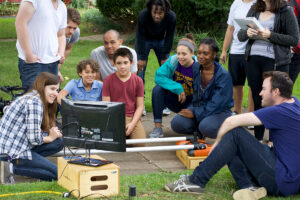Assistant Professor Andrew Twibell has been involved in filmmaking for over 20 years—first as a student, then a professional, before becoming a professor.
“Prior to coming to Missouri State I was based in Austin, Texas, where I worked professionally in documentary, narrative, music video, and commercial production. These days, my work as a filmmaker is focused on directing, editing, and producing. Each year, I try to direct and edit a short film, and typically produce or co-produce a few student-created projects, outside of traditional classwork,” Twibell says.

Twibell studied film production at Florida State University, an intensive hands-on program where students spend a large portion of their time on set. This experience prepared him to mentor Electronic Arts (EA) students through their rigorous senior projects as the program’s coordinator. Twibell has taught at Missouri State since 2013 and has always been a part of EA faculty, earning the title of coordinator in 2019.
“I’m thrilled to continue to be a part of this program. I’m always amazed at the caliber of work our students produce, and I’m priveleged to work with such a great group of faculty” — Andrew Twibell
EA is an interdisciplinary program in which students explore filmmaking, audio production and post-production, computer animation, and interactive media creation. The EA faculty is made up of eleven professors from three different departments. “Students choose a primary ‘track’ to focus on, but will gain experience and skills related to all four of those areas. The curriculum is flexible enough for students to tailor the classes they take in those disciplines, depending on their interests. The program is meant to allow students to develop their voices as storytellers while honing a diverse set of technical skills,” Twibell explains.

The are certain requirements for admission to the EA program, including a “pre-admission core” in which students must complete nine credit hours in survey production courses in film, audio, animation, and digital art. “Those classes are meant to help students learn basic skills, decide what they want their primary focus within the program to be, and start building their portfolio,” says Twibell. He goes on to explains that “the portfolio, which includes 2-3 pieces of the students’ strongest work, is a key component of the application process. That process also includes an essay detailing the applicant’s creative, academic, and professional goals, and an interview with EA program faculty.”
The EA program is unique from other majors in the media, journalism, and film department due to its integrative nature. “You have a primary discipline that you focus on, but you’re also developing creative and technical skills in other creative fields. EA also affords students the opportunity to work on a year-long, large-scale senior project, which serves as the program’s capstone experience,” explains Twibell.
Outside of his work as coordinator, Twibell is currently in post-production on a short film he wrote and directed called “Blue Dot.” The cast and crew of “Blue Dot” consist mostly of students in the MFA in Dramatic Writing and other media, journalism, and film students, as well as alumni. He’s also editing an indie narrative feature film directed by fellow EA faculty member Joy Millana. During recent years, he’s worked on “Golden Age” (2018), which premiered at the 2019 Kansas City FilmFest International and later received an Award of Excellence from the Broadcast Education Association. Twibell edited the 2020 faculty production “Between the Creag and Sky” (2020), directed by Dr. Kurt Heinlein. This project is still in the process of being submitted to competitions but has been screened at seven national and international festivals to date.



Leave a Reply